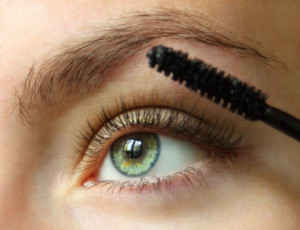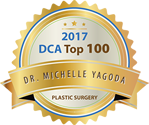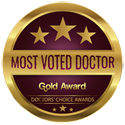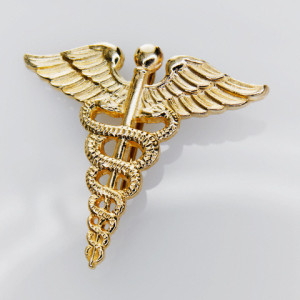1. What kinds of lash extensions are available? There are a few different lash enhancement options available, each with their own risks and benefits.
Strip Lashes-
They can be made from synthetic or human hair. They are useful when used as a temporary solution and for very short term wear. There is an unnatural heavy feeling on the lids. These are placed against the upper lash line as close to your natural lashes as possible. Applying a strip of lashes can be a daunting task. It requires a great deal of practice and patience. Even well applied lash strips can cause embarrassing situations as the temporary adhesive used to apply the lash strip can come loose due to heat and perspiration.
From a “lash health” perspective there are a few concerns. There is an increased risk of allergic reaction since there is a direct contact of the adhesive with the skin. Long term use of lash strips can occlude the lash line and block the hair follicle resulting in increased potential for permanent lash baldness. There is also an increased risk of infection. Care must be taken when removing the lash strips as to not pull out natural lashes while removing.
“Clusters” or “Flare” type Lashes-
These types of lashes have a slightly more natural look since they are bundles of three to eight blunt tipped lashes held together by a little knot. They are typically placed on top, in between, or underneath the natural lash line.
Similarly to strip lashes, flares or clusters are attached using an adhesive which comes in contact with skin, and they pose the same risks of allergic reactions, damage to the hair follicle, and risk of infection. If a temporary adhesive is used, they can come off due to heat and perspiration. Many salons offer these types of “lash extensions” with a stronger more permanent adhesive. This type of eyelash extension can cause permanent damage to the hair follicle with repeated use. Since they are placed on top or under the natural lashes, they are attached to a few or your own natural hairs. When it is time for your natural to shed (all of our natural lashes are at a different growth stage), the cluster will also remove other lashes that are still intact. This can result in bald patches in your lash line. Everyone’s threshold for lash regrowth is different. Repeated injury to the lash line can cause permanent damage. Because of the method of application, they can also be quite uncomfortable and cause pain. You still feel the “knot” of the cluster as well as the pain associated with the cluster pulling the hairs from the root.
Semi Permanent Eyelash Extensions-
Semi permanent eyelash extensions are made to mimic natural lashes. They are placed one by one to your natural eyelashes. A single extension is bonded to a single natural lash. These types of lash extensions are the least damaging to your natural eyelashes. They are light, natural looking and natural feeling. A medical grade adhesive is used to bond each lash individually. The adhesive does not come in contact with skin and is only placed on the eyelash.
2. What are the risks of extensions?
Risks of wearing extensions vary with the type of extension used. Strips, clusters, and flares carry an increased risk of allergic reaction and infection due to the contact with skin and potential for the occlusion of the follicle. There is also a risk for permanent damage to the follicle from lashes being pulled from the root prematurely.
Poorly applied semi permanent eyelash extensions can also carry the same risks as flares and clusters. Technique is very important. The stylist must be precise with application, not connect the extension to your skin, and be sure t only apply a single extension to a single eyelash as well as choosing appropriate size and thickness of the extension. It is important that your natural lash can support the weight of the extension and not place stress on the natural eyelash follicle.
3. Which treatment do you recommend and why?
I prefer and recommend semi permanent lash extensions. While they are the most expensive option, they carry the least risk and are the most natural looking and feeling. They also involve the least amount of maintenance. I do not offer any other type of lash enhancement due to the risks involved. Properly applied and maintained eyelash extensions do not damage your natural lashes.
I also love the ability to contour the lashes to enhance our most noticed feature- our eyes. Semi permanent lash extensions can make you feel younger, fresher, and more polished.
4. What is the maintenance required?
Since our natural lashes shed at different rates, touch-up appointments are necessary to attach an extension to the new growth. The majority of my clients come in every three to four weeks for a one-hour maintenance visit. They are actually quite simple to take care of and every client loves the ability to wake up feeling beautiful without the hassles (and clumpiness) of mascara.
5. Beauty Scoop is called the edible beauty accessory. Do you believe that it can help your eyelashes and your overall beauty?
I definitely believe Beauty Scoop can help your eyelashes and overall beauty. Nurturing and nourishing your beauty from within and promoting hair growth can positively affect overall “lash health.”
 BDD is a type of mental illness in which negative thoughts of body image overwhelm someone to the point that it negatively affects his or her life, getting in the way of healthy relationships, careers, and socializing. The disorder can lead to suicidal thoughts, eating disorders, depression, anxiety and — as seen in this study — unnecessary cosmetic surgery.
BDD is a type of mental illness in which negative thoughts of body image overwhelm someone to the point that it negatively affects his or her life, getting in the way of healthy relationships, careers, and socializing. The disorder can lead to suicidal thoughts, eating disorders, depression, anxiety and — as seen in this study — unnecessary cosmetic surgery.
































 rican Life Project, 83% of internet users are searching for medical information on-line and 59% of all US adults have looked on-line for health information. Despite this, there is significant documentation to show that patients are confused about who is providing their health care.
rican Life Project, 83% of internet users are searching for medical information on-line and 59% of all US adults have looked on-line for health information. Despite this, there is significant documentation to show that patients are confused about who is providing their health care. Take, for example, a child with protruding ears. Ear pinning (otoplasty) can restore the ear size, shape, and position to normalcy. After the age of six, otoplasty is safe, fast, and virtually painless. So why subject a child to a lifetime of “Dumbo” jokes? An otoplasty in an otherwise physically, emotionally, and socially healthy child can be a surefire way to prevent bullying. The same is true of exaggerated nasal features. Oversized, crooked, or oddly shaped noses are often a source of relentless teasing among children. Surgery that restores normal nasal structure and function has long been accepted by well-adjusted teens, their parents, and doctors, so why stand by and watch a child experience a painful loss of confidence? While surgeries to improve the appearance of a child’s ears or nose have long been popular, a newer cosmetic procedure is also on the rise. Those who suffer from unwanted hair, such as girls with upper lip hair or thick sideburns, may want a lasting solution to avoid being taunted by their peers. Laser hair removal is now becoming a more common alternative to waxing, depilation creams, and the dreadful shaving.
Take, for example, a child with protruding ears. Ear pinning (otoplasty) can restore the ear size, shape, and position to normalcy. After the age of six, otoplasty is safe, fast, and virtually painless. So why subject a child to a lifetime of “Dumbo” jokes? An otoplasty in an otherwise physically, emotionally, and socially healthy child can be a surefire way to prevent bullying. The same is true of exaggerated nasal features. Oversized, crooked, or oddly shaped noses are often a source of relentless teasing among children. Surgery that restores normal nasal structure and function has long been accepted by well-adjusted teens, their parents, and doctors, so why stand by and watch a child experience a painful loss of confidence? While surgeries to improve the appearance of a child’s ears or nose have long been popular, a newer cosmetic procedure is also on the rise. Those who suffer from unwanted hair, such as girls with upper lip hair or thick sideburns, may want a lasting solution to avoid being taunted by their peers. Laser hair removal is now becoming a more common alternative to waxing, depilation creams, and the dreadful shaving.